| 1 | Attains towering heights |
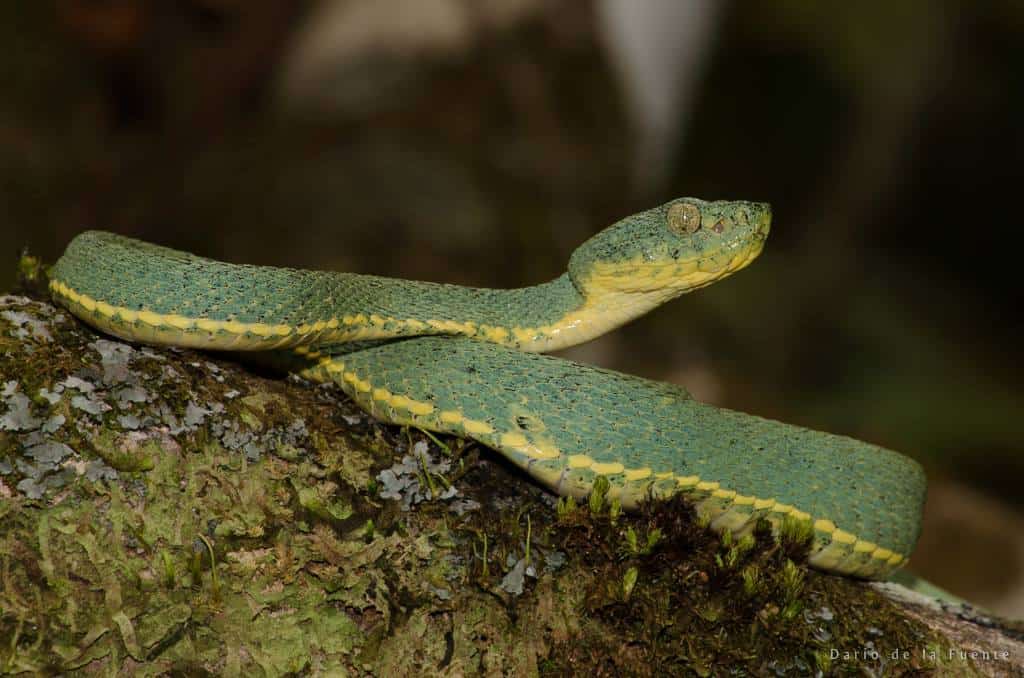
The Bothrops family is Brazil and South America’s signature venomous family, including nightmares like the common lancehead and jararaca. Some roam riverside meadows and savannahs, but Bothrops bilineatus is the member most restricted to forests. This snake lives in Brazil, Columbia and Peru, and sticks almost completely to primary and secondary rainforest, occasionally slithering around cocoa plantations directly adjacent to forests.
This snake is nocturnal, and most commonly spotted resting on tree branches. Bothrops bilineatus is the strongest climber of the Bothrops family; the likes of b. insularis and b. taeniatus also climb trees, but b. bilineatus reaches the most towering, death-defying heights. In a 2021 study in the Lower Moa river forest of Acre state, Brazil, several Bothrops bilineatus climbed to 10 metres above ground, and one to 20 metres. These weren’t mere exploratory missions, as they waited in the canopies for several days to ambush frogs.
The same study found an average branch resting height of 6.4 metres, while a 2019 study watched a Bothrops bilineatus perch itself at 9.4 metres above ground for 3 days straight. At the time, this was considered a record, but it only took 2 years to be defeated by the 2021 study.
| 2 | Appears during dry season |
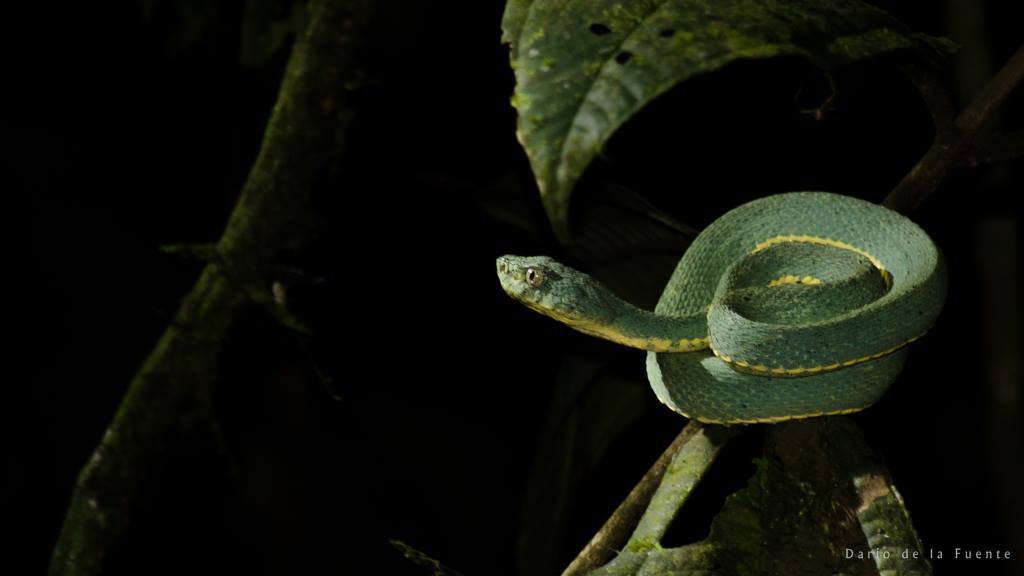
Despite being an ambush predator, Bothrops bilineatus isn’t as lazy as the emerald tree boa. The more active ones will change position every 24 hours, sometimes moving to a new branch, sometimes to a new tree. Adult Bothrops bilineatus rest on branches, while the youngsters are light enough to rest on thick leaves. They’re helped by a flexible, prehensile tail with strong gripping abilities. Within rainforests, they tend to like areas with streams nearby, as these form breeding grounds for their frog prey.
In Brazil, the feared Bothrops atrox is most commonly encountered during wet and warm months. Bothrops bilineatus is the opposite, appearing during the dry season. When skies are overcast, forest trails are flooded, and leaves are dripping with water, they completely disappear. One study in December to March failed to locate a single snake. Dry season is when they descend from their 10 metre high perches, which is conversely because humidity levels fall faster higher up, and the ground retains more moisture.
| 3 | The acai berry curse |
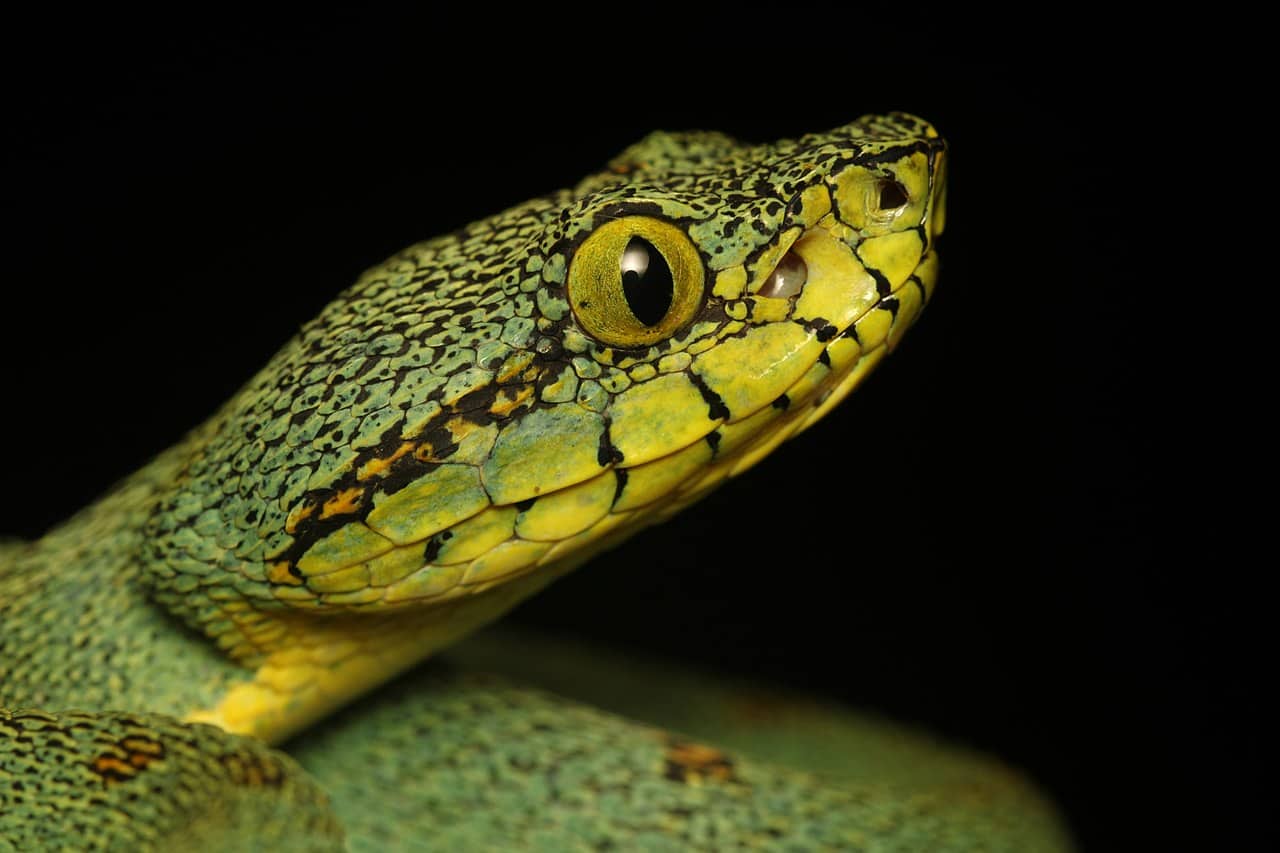
One of Brazil’s top health food experts is the small, black acai berry, hailed for its supposedly miraculous antioxidant properties. Acai berries are said to far outstrip red grapes in health, but little do their fans realise that the farmers are having dodge Bothrops bilineatus to get them! The species often rests on branches closer to the ground as well, and the acai palm (Euterpe precatoria) is one of their favourites. Another favourite plant is the para passiava (Leopoldinia piassaba).
In some places, Bothrops bilineatus causes the 2nd highest snakebite total. These include Cruzeiro do Sul, Brazil, and Leticia, Columba. Most bites happen when slashing new forest trails, or harvesting rainforest resources. The disguise is so total than when resting 1 metre above ground, the villagers completely miss them, until they’re within breathing distance and it’s too late.
In two recorded bites from Acre State, Brazil, harvesters were bitten 4 and 8 metres in the air, as they climbed high up acai palms and unwittingly disturbed snakes. You only have to brush against one with your shoulder to activate its defensive response. In some regions, Bothrops bilineatus causes as little as 3% of snakebites, but in others they cause 36%.
| 4 | Scorching bite wounds |
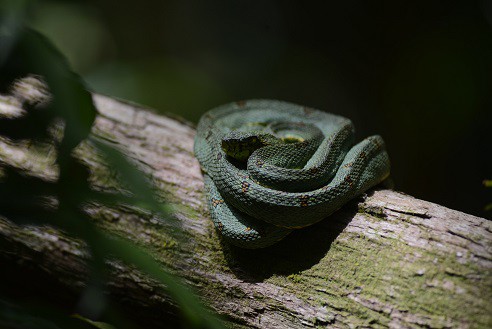
Bothrops bilineatus venom has a relatively weak LD50 rating of 6.24mg, versus 0.46mg for a jararacussu. Deaths are relatively rare, but the bite cause unending local chaos: redness, swelling and intense pain. The one symptom that constantly appears in medical logs is heat, that the puncture marks become fiery hot. There’s severe swelling, accompanied by burning sensations, although there’s relatively little necrosis.
The main internal symptom is spontaneous bleeding, including from the gums, eyes, nose and of course bite mark. At least 1 death is on the records, and patients have produced brown-black urine before due to an attack on the kidneys.
American explorer William Beebe had a nasty encounter with this snake, reported in 1946. He walked within 1 foot of a Bothrops bilineatus, resting 5 feet high on a bush. It struck towards his face, but as he crouched below a bush, it harmlessly struck the rim of his hat instead. Beebe then broke its back with the barrel of his gun. Because of their cosy branch perches, the majority of Bothrops bilineatus victims are bitten on the chest, shoulders or hands.
| 5 | Green but also black |
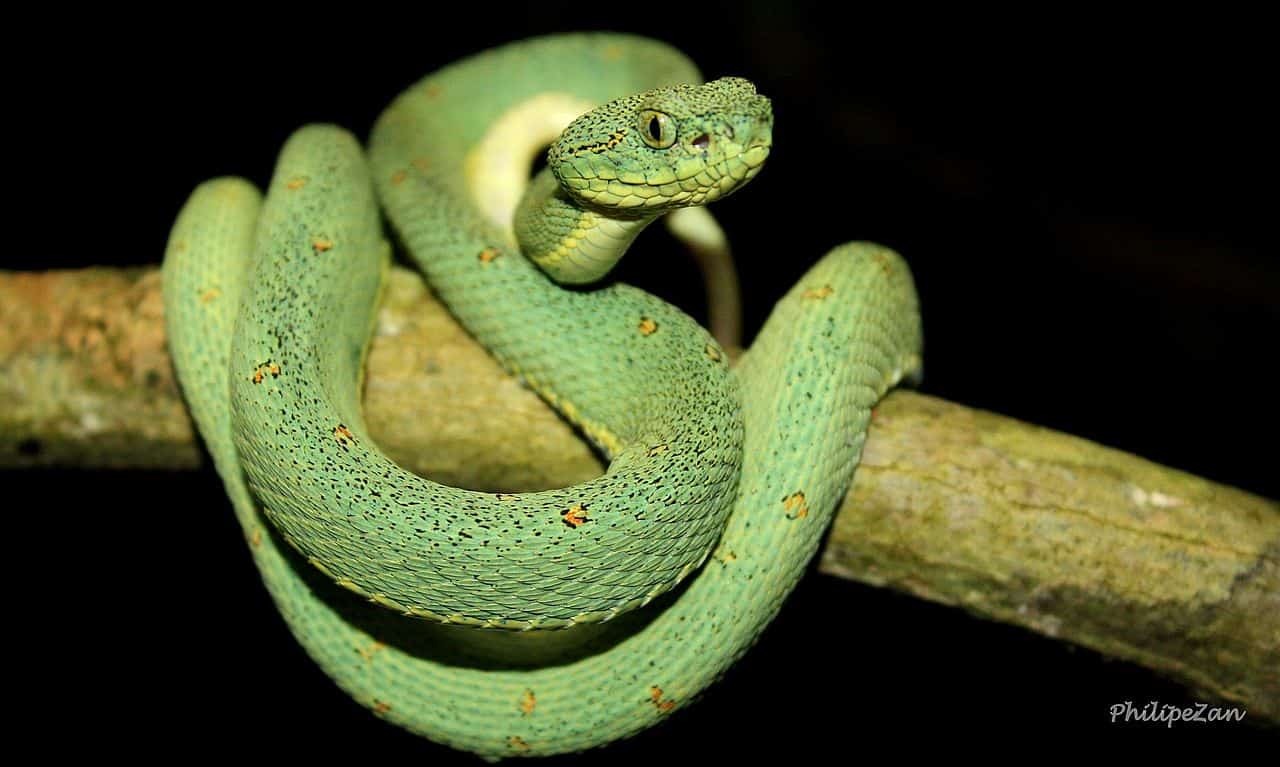
Some of the Bothrops family snakes blend together, but Bothrops bilineatus is easy to recognise. It’s much thinner and greener than the others, particularly the whip-like tail. This snake isn’t particularly long, averaging at 73cm. The all time records were 123cm and 120cm, found in Venezuela. In a study from Acre State Brazil, the longest female observed was 75.8cm while the longest male reached 66.8cm. Females are longer than males in almost all Bothrops snakes.
This is clearly a green snake, but up close, it’s more subtle, as each green scale is bordered by black. Bothrops bilineatus has yellow irises with a green tinge, with vertical pupils. Its tongue is pinkish grey, with a dark grey tip, which is visible as it flecks around searching keenly for frog scents. Some Bothrops bilineatus has red coloured spots on their sides, which the western subspecies B. bilineatus smaragdinus lacks. Others have black spots on their head, but the vivid forest green is always in place. Their belly is a yellow colour, with green tinges around the edges.
| 6 | Tempts prey with pink tail |
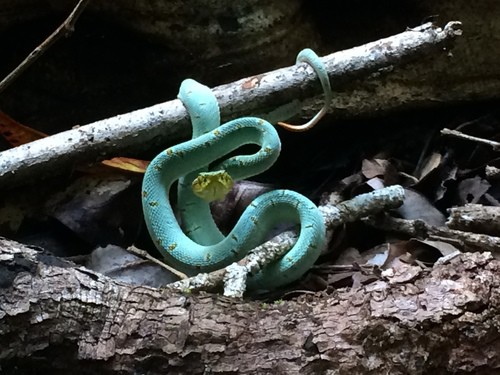
The most obvious exception to the greenness is this snake’s white or even bright pink tail. This probably mystified early machete-wielding explorers, but the tail is actually a cunning hunting strategy: caudal luring. From its branch perch, Bothrops bilineatus will move its bright tail up and down its coiled body, wriggling the thin end in a sinuous fashion. The goal is to lure in frogs by imitating a worm or insect. Frogs are highly reliant on visuals, and the pinkness will stand out in a jungle environment.
Many snakes worldwide use caudal luring, but Bothrops bilineatus is top in the Bothrops family. Other Amazon pitvipers like B. jararaca and B. moojeni use it as juveniles, but lose the tail colouring in adulthood. Bothrops bilineatus keeps the pinkness its entire life. They even use caudal luring when there’s no prey nearby, probably because the jungle is so thick, and it’s trying to flush out hiding prey it hasn’t noticed.
Height isn’t a question here, as one study observed Bothrops bilienatus perched from 0.3 metres to 17.97 metres. This tricksy caudal luring was observed at all heights. The snakes clearly felt secure on even the most towering branches; they didn’t get unnerved and shift their focus more towards balancing.
| 7 | Grabs frogs from branches |
After lunging from their branches in ambush, Bothrops bilineatus always holds onto its prey tightly while the venom takes effect, rather than releasing and watching. 50% of its diet consists of amphibians, particularly frogs:
Marmorea frog (Dendropsophus marmoratus) – widespread across the Amazon. Feeds on beetles and ants. Likes to sit in pools on the forest floor and sing in choirs, but also found 20 metres high on branches.
Red snouted treefrog (Scinax ruber) – an extremely common South American frog, which has also invaded Puerto Rico. This light brown frog has beige eyes and can lay up to 590 eggs at once. It also lives beyond the Amazon in forest clearings and public parks.
Osteocephalus taurinus – a poisonous frog which produces the heart-stopping bufotenin. Lays up to 2000 black eggs, in a film that lies on ponds. Often seen on tree trunks and branches. Widespread, found in Peru, Ecuador, Brazil and more.
These three frogs live mainly on branches themselves, in a micro branch universe where Bothrops bilineatus is the ultimate antagonist. This is also a bat-eating snake, confirmed to munch on silky fruit-eating bats (Carollia brevicauda). A confirmed lizard prey is Gonatodes humeralis.
| 8 | Shows up randomly |
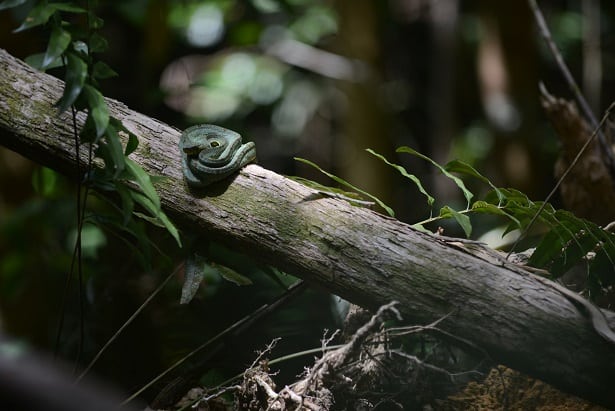
The strange thing about Bothrops bilineatus is how unpredictable it is. Sometimes you can walk into a forested grove, with all the box-ticking shallow streams and high towering canopies in place, yet not find one snake. It doesn’t obey the rules assigned to it by the neat categorisation of science.
There’s a large swathe of the Amazon where Bothrops bilineatus is relatively rare. In a collection of 4 studies from different regions of Brazil, they only made up 0.16 to 1.34% of snake sightings. Yet a study from the lower Moa river, Acre State, found that it was the single most common snake, making up 28.46% of sightings. Bothrops bilineatus is also completely missing from Manaus region (north of the Amazon river) for no apparent reason, despite being in the centre of its range.
Anyone hunting for this snake could be severely disappointed, or hit the jackpot – there’s no way to tell. Being nocturnal and extremely green, it’s difficult to find them deliberately anyway.
| 9 | No specific antivenom |
Brazil has several antivenoms for dealing snakebites, but not one made using Bothrops bilineatus venom. Bothrops AV is one three staples stocked by hospitals, alongside Bothrops-Lachesis AV and Lachesis AV (made from South American bushmasters). Bothrops AV is made from 5 species: 50% Bothrops jararaca (a monstrous snake), with the remaining 50% divided between b. neuwiedi . b. moojeni. b. jararacussu, and b. alternatus. As usual, the venoms are injected into hyperimmune horses, which produce extractable antibodies in response.
So are Bothrops bilineatus victims alone, with no-one coming to help? Fortunately not, because all Bothrops species have a large crossover in toxins. A study on 68 b. bilineatus victims found that standard Bothrops antivenom had a high success rate anyway. A bite victim from 2007 was stabilised with the antivenin, restricted to swelling, with no haemorrhaging. This victim had the usual fiery red wound, as according to the doctor: “the burning sensation was for real, the entire left arm was much hotter than the rest of the body“.
| 10 | The 2 (but maybe 4) subspecies |
The Bothrops name is the snake’s wider family, but bilineatus refers to the patterns on its flanks. Lineatus means “striped with lines”, while bi means two. Officially, this tree snake is divided into two subspecies: Bothrops bilineatus bilineatus, and Bothrops bilineatus smaragdinus. The first occupies eastern Brazil, plus an isolated enclave in Brazil’s Atlantic forest, a forest fuelled by the Atlantic ocean which is totally separate from the Amazon. B .b. smaragdinus is the western subspecies, occupying western Brazil, Peru, Venezuela, and Columbia. Both favour dense, branchy forests. The main difference is physical; B. b bilineatus has red or yellowish spots over the green, while B. b. smaragdinus has small black spots.
Recently though, DNA analysis has questioned the old 2 subspecies belief. It concluded that Bothrops bilineatus is divided into 4 genetic clades with chasms between them: 1) Atlantic Forest 2) Guiana Shield 3) Western Amazon; and 4) Central Amazon. The first had a closer relationship, but the western and central clades were distant. It’s possible that Bothrops bilineatus is really three, possibly four subspecies. The limit of the western Amazon clade was the Orinoco river, while the central clade was found south of the Amazon river in Brazilian states such as Amazonas, Rondônia, Mato Grosso.